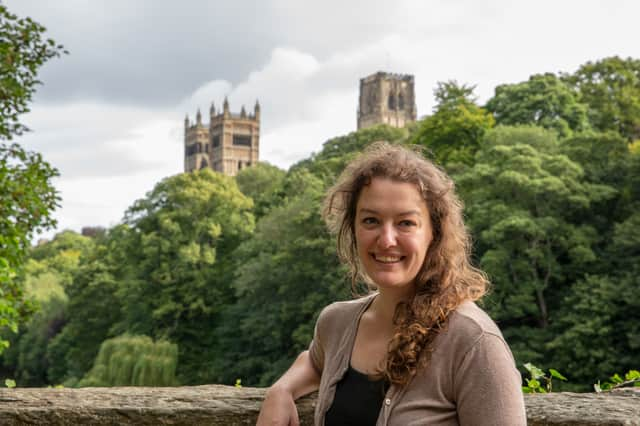American academic to walk 'death march' route of Scottish prisoners held in Durham Cathedral
and live on Freeview channel 276
An American academic will next week pay a personal tribute to hundreds of young Scots prisoners-of-war who died as the result of a 17th century “death march” and the deadly horrors they faced in captivity.
Megan Olshefski, a 29-year-old Californian, has devoted years researching the lives of those forced into a week-long trek from defeat at the Battle of Dunbar, in September 1650, to a make-shift prison in Durham Cathedral.
Advertisement
Hide AdAdvertisement
Hide Ad

About 4,000 captives, judged a viable threat to Oliver Cromwell’s victorious army, were marched south across the border at Berwick and then on to Belford in Northumberland.
The onward journey took them to Alnwick and after days without food they ate cabbages and root vegetables on arrival within walled gardens at Morpeth.
They continued to Newcastle Cathedral but just about 3,000 were eventually herded into their final destination in Durham where, under lock and key, they faced months of unspeakable squalor and disease with the last of the prisoners leaving the cathedral in July 1652.
With inmates sleeping cheek by jowl there was no protection from an outbreak of dysentery.
Advertisement
Hide AdAdvertisement
Hide AdCoupled with starvation, hypothermia and murderous squabbles over clothes and possessions, just 1,600 survived.
Megan, a history graduate now studying for a doctorate at Durham University’s Department of Archaeology, is nearing completion of her research into the captives’ struggle for life – and, for some, eventual freedom following a period of forced labour in the American Colonies.
She will set out on September 3, the day of the battle, to walk the same near 100-mile route as the battle-weary prisoners.
“I plan, where possible, to spend each night on the site of each stop-over and follow a traditional 17th century Scottish diet of the period, which includes oats, peas, fish, brassica and kale,” said Megan, whose mother’s family can trace her roots back to Scotland.
Advertisement
Hide AdAdvertisement
Hide Ad“Conditions in the cathedral were truly horrific for captives whose average ages ranged from just 15 to their mid-20s.
"They used the east end of the cathedral as a toilet and slept when and where they could in the west end because of the chronic lack of floor space.
“My intention in making this trip is to honour all those involved – particularly the ones who did not survive,” she said.
Megan’s first introduction to the marchers’ story and the privations they endured came when she was a young graduate working as a researcher and producer on the American equivalent of the British television programme “Who Do You Think You Are?”
Advertisement
Hide AdAdvertisement
Hide AdOne episode focused on James Adams, one of 150 randomly selected prisoners shipped out from London to New England. On arrival in Boston in the winter of 1650 he and his fellow travellers were forced into indentured service, legally tied to investors across the colonies.
Thirty-five passengers were assigned jobs in the Saugus Ironworks, one of the first major industries established by the English in New England.
They were released from bondage between five and seven years later and offered freedom to start a new life among the Puritan colonists.
Many built rudimentary homes, raised families and lived long lives, some reaching their 90s.
Advertisement
Hide AdAdvertisement
Hide AdAs part of her research Megan has taken part in archaeological digs and surveys on the sites of those early homesteads and places of labour.
She plans to publish a book as well as record a video of her pilgrimage along the route of the walk.
She explained: “Records examined by the American programme researchers confirmed the names of all those who sailed to Boston and were indentured at the ironworks, a key link to descendants tracing their family tree, starting with the Unity, the ship which brought the prisoners across the Atlantic.”
Research into this poignant piece of history has been keenly followed by tens of thousands of Americans, fiercely proud of their Scottish heritage.
Advertisement
Hide AdAdvertisement
Hide AdIn some cases they plan to relive their ancestors’ story by coming to the UK and visiting Scotland and north east England.
The cathedral’s dead were buried in a mass grave now under the buildings of Palace Green and the buildings within the surrounding area.
The major new find of the mass grave was made during work on a new café in 2013. Despite the large number of deaths it has been possible to recover only 28 incomplete skeletons.
Megan’s sobering journey will end at Durham Cathedral’s North Door at 4pm of Saturday, September 9.
Advertisement
Hide AdAdvertisement
Hide AdShe will be met by a welcoming party which will include the Mayor, Councillor Lesley Mavin, the cathedral’s Canon the Rev Michael Everett and representatives of the Rotary Club of Durham who, along with Megan’s college and a trust set up by the University’s renowned archaeologist Dame Rosemary Cramp, have supported this academic adventure.
Comment Guidelines
National World encourages reader discussion on our stories. User feedback, insights and back-and-forth exchanges add a rich layer of context to reporting. Please review our Community Guidelines before commenting.